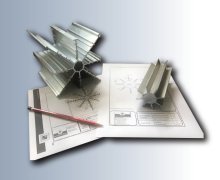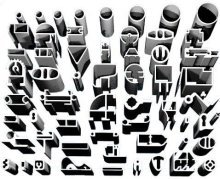



Barres Étirées à Froid
Tubes Étirés à Froid
5083
Cold Drawn/Finished (CF) / AlMg4.5Mn0.7 (Soğuk Çekim) / 5083 / O
| Chemical Properties | % Value |
| Silicon (Si) | 0,00 - 0,40 |
| Chromium (Cr) | 0,05 - 0,25 |
| Magnesium (Mg) | 4,00 - 4,90 |
| Copper (Cu) | 0,00 - 0,10 |
| Titanium (Ti) | 0,00 - 0,15 |
| Iron (Fe) | 0,00 - 0,40 |
| Zinc (Zn) | 0,00 - 0,25 |
| Aluminium (Al) | Balance |
| Manganese (Mn) | 0,40 -1,00 |
| Physical Properties | Value |
| Density | 2,66 g/cm³ |
| Melting Point | 580 °C |
| Thermal Expansion | 23.8 µm/m°C |
| Modulus of Elasticity | 68 GPa |
| Thermal Conductivity | 117 W/m.K |
| Electrical Resistivity | 29% IACS |
| Mechanical Properties | Value |
| Proof Strength | 140 MPa |
| Yield Strength | 290 MPa |
| Shear Strength | 172 MPa |
| Elongation A50 mm | %17 |
| Hardness | 71 GPa |
Plate and Sheets per: 5083 O, AMS QQ-A-250/6, ASTM B209, ISO AlMg4.5Mn0.7, DIN AlMg4.5Mn, UNS A95083, ASTM B928, WNR 3.3547
Extruded Round/Flat Bar and Tube per; 5083 O, ASTM B221, UNS A95083, ASTM B928, WNR 3.3547, AMS QQ-A-200/4
Seamless Extruded Tube; 5083 O, ASTM B241, UNS A95083, WNR 3.3547, ISO AlMg4.5Mn0.7, DIN AlMg4.5Mn
Cold Drawn Round/Flat Bar and Wires; 5083 O, ISO AlMg4.5Mn0.7, DIN AlMg4.5Mn, UNS A95086, ASTM B241, WNR 3.3547
Choosing Factors for 5083 O
- Strength: Very good
- Machining: Poor
- Weldability: Good
- Formability: Average
- Corrosion Resistance: Very good
- Heat Treating: No
Some Well-Known Applications for 5083 O
It is also used in shipbuilding materials,
Storage tanks in the marine sector,
Car chassis in the automotive sector.
- Plate
- Sheet
- Rod / Round Bar / Flat Bar
- Tube/Profile

 Calculateur de Poids
Calculateur de Poids

